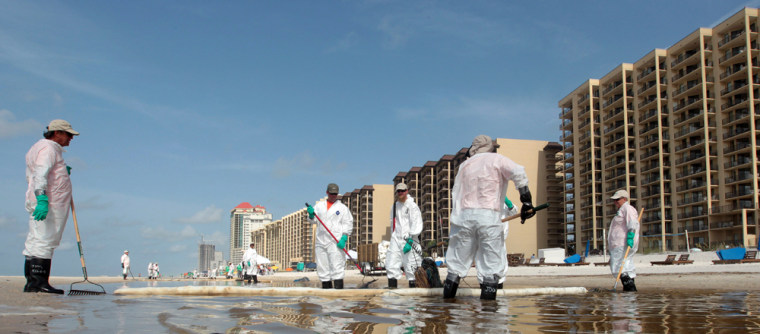With pockets as deep as BP’s — its assets are worth more than $260 billion — the possibility that it might be forced to seek bankruptcy protection because of the Gulf of Mexico oil spill is considered remote by many industry experts.
But what if the company’s plan to contain the spill in the next several days does not work, and other efforts to stop the gushing oil also fail? If that were to occur, the worst-case projections of some experts, if they came to pass, would strain the ability of any company to pay, said Robin K. Craig, associate dean for environmental programs at the Florida State University College of Law.
Professor Craig said that if the oil hit the Gulf Stream and was carried by currents to East Coast states, Cuba and other Caribbean nations, and possibly even Britain, lawsuits could quickly mount to levels even BP could not handle.
“My bet is that BP will finally go bankrupt from the tort liability and the environmental liability,” she said. “Hypothetically, a bluefin tuna farmer in the Mediterranean could end up with a claim against BP.”
Even those who find it unlikely that BP will seek bankruptcy protection believe it is likely that the company has to at least consider it as a possibility, in light of spiraling environmental costs, economic claims and the unpredictability of American juries.
“They’ve got a duty to their shareholders and others to consider every possibility,” said Samuel J. Gerdano, the executive director of the American Bankruptcy Institute. “It’s not a matter of panic, it’s not a matter of irrationality. It’s a coldhearted and clearheaded consideration of options.”
A BP spokesman, Max McGahan, declined to comment on “hypothetical” questions. The company has said from the start that it has the resources to meet the economic challenge, including strong cash flow and billions of barrels of oil in proven reserves.
A previously unreleased memorandum by the Congressional Research Service outlined ways that a bankruptcy filing by BP could disrupt the cleanup and compensation.
The letter, prepared in response to questions from Senator Thomas R. Carper, Democrat of Delaware, stated that economic and environmental claims would fall into line behind the company’s secured creditors as “nonpriority, unsecured claims,” leaving much of the continuing cost of cleanup, in all likelihood, to the federal government. With a judge’s approval, the company’s assets could even be sold and its liabilities left behind.
Government officials are pursuing contingency plans as well. The United States Department of Justice sent a letter to BP last month requesting at least 30 days’ notice of “any planned or contemplated events going forward that may involve substantial transfers of cash or other corporate assets outside of the ordinary course of business” by BP — the kinds of actions that might precede a bankruptcy filing.
The House of Representatives has passed a bill, introduced by Representative John Conyers Jr., Democrat of Michigan, that would limit BP’s options in bankruptcy and bolster the rights of those with economic claims.
Under the proposed law, the sale of “significant” assets in bankruptcy related to a maritime incident could take place only with the approval of at least half of those holding claims for economic loss, or a determination by a judge that the company would still be able to pay claims.
Many experts who have looked at the financial strength of BP said its ability to handle enormous liability claims should not be underestimated.
Loretta Cross of the accounting and consulting firm Grant Thornton, who evaluates the assets of energy companies in bankruptcy, noted that the company’s proven oil and gas reserves alone were worth $220 billion at today’s prices, and that assets and equity that could be readily sold added another $40 billion.
“That’s just some of their assets,” she said, adding that the company’s debt is a relatively low $35 billion, leaving plenty of room for borrowing.
Ms. Cross also said BP could not afford the cost to its reputation that it would suffer in bankruptcy.
In the international arena, she said, “it has an implication on how your business partners may treat you, and the credibility they may give you” in future dealings.
If anything, worries that BP might unravel have eased in recent weeks, as the company has made steady progress on relief wells and announced the $20 billion settlement fund.
“Their agreement to do the trust was when I said, ‘There’s not ever going to be a bankruptcy here,’ ” Ms. Cross said, because the fund serves as an alternative to the lawsuits that are massing against the company.
Kenneth R. Feinberg, the administrator of the $20 billion fund to address economic losses from the spill, recently said in an interview on Fox News that a BP bankruptcy would be a “disaster for the people in the gulf” and is “not an option.”
Ian Williams, a bankruptcy lawyer at the firm Bryan Cave in Britain, was adamant that bankruptcy was out of the question.
“BP does not need to reorganize its business because it is solvent,” he said, adding that the global importance of the company and its stock made it “too big to fail.”
A plaintiff’s lawyer in New Orleans, Stuart H. Smith, said he had watched BP carefully for signs that it was moving to protect assets in bankruptcy.
“My concern level is now less than it was,” he said. Along with the creation of the Feinberg fund, which he said showed a commitment to stay the course, he added, “We’ve done more homework — they are a very deep, deep company.”
Still, he said, the main concern remained the well itself.
“Until it stops leaking,” he said, “nobody knows what the damages are.”
This story, "," first appeared in The New York Times.
